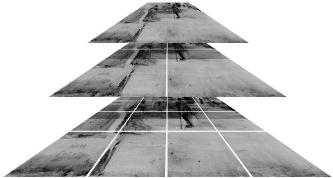
Multiscale Pyramid Structure
 [Back to the Index]
[Back to the Index]
The module allows retrieval of similar images based on the general colour distribution of the image and sub-images, with discrimination between colours in images which are homogenous to some sizable area.
The module is good for retrieval of images based on a known query image if the retrieved images are required to contain an area with a similar mix of colours to the query image. This means it is also suitable for retrieval of images based on a query image which is only part of a complete image.
This module divides database images into a heirarchy of small patches and the CCV is calculated for each patch. The query is compared with all patches so that sub-images may be located in the parent image.
| Module Speed | Slow |
| Module Accuracy | Very-High |
The detail finder finds sub-images by dividing the query and the database image into a number of tiles over a number of resolutions calculating the CCV for each of the tiles.
 Multiscale Pyramid Structure |
The highest resolution image is converted into 64x64 tiles, overlapping by 32 pixels in each dimension. The image resolution is halved and, again, divided into 64x64 tiles (of which there will be 4 times less). The lowest resolution is of 64x64 pixels and 1 single tile.
For each tile a CCV is created and stored, so that the final feature vector is a set of CCV feature vectors, one for each tile.
Both the query image and the database image are converted into a pyramid structure, and then each of the tiles in the query image are compared against each of the features for the tiles in the database image using the CCV matching algorithm, as described on the CCV Help Page.
The query is converted to a pyramid to facilitate the database image being a subimage of the query image (double sub-image detection). An alternative is to assume the query is a subimage of the database image only, and perform a CCV match of the whole query image against each of the tiles in the database image.
The following is an example query giving what would be considered good results.
Note: The matching is based only upon the general colour layout of the images and subimages.
 |  |  | 
|
| Query | 1 | 2 (click for zoom) | 3 |
 |  | 
| |
| 4 | 5 | 6 |
In the above example, all the retrieved results contain areas of contiguous skin like colour, and areas of contiguous dark-brown in a similar way to the query. Also note, that the query image, despite its diminuitive size, has been found in the original image from which is was taken.
Because the MCCV is a multi-scale version of the CCV, you can expect all the same types of properties and shortcomings. Used on its own you should definitely not expect the MCCV algorithm to be able to find specific instances of objects (e.g. chairs, pots, etc). However, when used with a metadata search to locate similar objects, this algorithm could locate those of a similar colour.